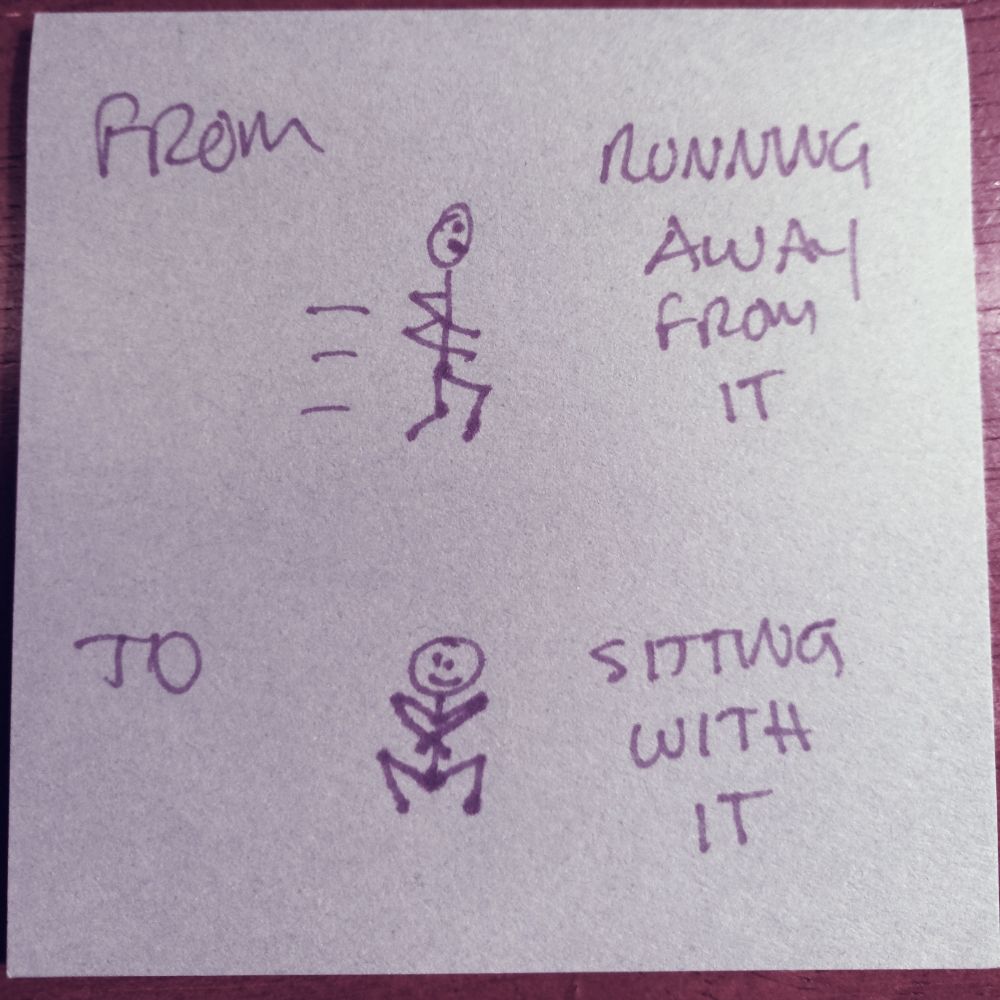Moment of Mind January 2020


Moment of Mind
Is Procrastination in a Feeling-Avoidance Strategy?
This past week I had an insight when I noticed my self procrastinating (again) and realized: oh my - this is me avoiding feeling! I use the word “insight” to describe when I see into a situation with deeper understanding. It felt like a bigger deal than the stick figure illustrates above. What I noticed was that procrastination was an innocent self-protective avoidance strategy, a way of running away from the thought-feels already in the system. I use the hyphenated concept “thought-feels” to describe when there is chatter in my mind, or patterned thinking in my unconscious, and the body has echoes of those thoughts showing up as feelings or sensations.
It’s all the same biological stuff: signals of information brought into awareness. The chatter was my mind self-protectively traveling into the future and forecasting possible negative outcomes. Thoughts like “I’m going to fail” or “I’m not good at this” or “no one will like what I have to say” are well intentioned thoughts my brain was generating in case that could protect from potential threats. Isn't one of the guidelines for giving presentations all about overpreparing? My mind doesn't notice when that's already happened, it just keeps going with the fear stuff. My body responded to those thoughts with more signals: it tightened up protectively, breathing became shallow, and my chest hurt. You might notice something like this too. That even when you can’t hear words in your mind, your body gives you signals that reveal a stress response. I know that I am not in charge of when these thought-feels show up in my mind, just like I am not in charge of the digesting happening in my stomach or my chest tightening. All of these experiences show up because life is moving through. These are all life experiences I get to have. The cool thing was that when I realized the self was running from the feeling, I knew then that I could also help it stop running. That the mind had been on auto-pilot and I had not been aware, and now that I'd noticed it, I could use my attention to support the system. Mindfulness is directing our attention into our moment by moment experience on purpose and letting judgment go.
I realized that running from the signals was adding more signals into the system. Resisting the feeling was adding more thought and more feeling on top of what was already there. Curious, I stopped and listened for whatever chatter might be there. I inquired, “what am I feeling right now?” and identified different feelings: I felt fear, I felt sad, I felt disappointed about procrastinating, I felt judged (by my own mind!!), and I felt guilty for procrastinating. And then I sat down for a pause and intentionally let the self FEEL each one of those feelings fully, one by one. I know, it sounds bizarre - why would I willingly turn toward feeling bad?
Society conditions us to avoid feeling bad at all costs - as though it were possible to avoid life. Life is a continual stream of dual experiences: hot and cold, ease and disease, happy and sad, pleasure and pain and the infinite gradations between. You cannot know contentment without also knowing what discontent feels like.
Life just keeps bringing more thought-feel experiences. It was so simple…and yet so challenging to go against social conditioning and turn toward the feeling and to just be with it. It wasn't "acceptance" and it wasn't passive. It wasn't wallowing either. It was like I was my own active, compassionate, witness.
The procrastinating had already felt difficult so I figured I didn’t have anything to lose. I turned toward those feelings and sat with each one the same way I would let a friend cry on my shoulder. I asked “what feels stable right now?” and when I felt the ground below I knew that there was stability inside too, and that I could let the system do what it was going to do in that moment. It was safe to feel the fear, to feel the sadness, the disappointment, the judgment. I didn't have to run from it. After a few moments of yuck, the feelings moved, the thoughts moved, and my body relaxed. It was gone. It was like my self-identity had a tantrum and then it was over. I would love to hear what you notice when you explore what it’s like to hear a thought, or feel a feeling and then to turn toward it and sit with it - the way you would with anyone you love.
Love For Your Inner Science Nerd
Sleep and Stress
Last week I held an introductory webinar on sleep and stress which you can see here. In conducting a literature review on sleep and stress physiology I learned that sleep and some mental health challenges such as paranoia, anxiety, and depression have overlapping neural networks and neurotransmitters.
While it wasn’t surprising to learn that a lack of sleep can contribute to a feeling of anxiety, and that feeling anxious can contribute to challenges with sleep what was surprising is a 2017 study that indicated helping college students get better sleep through using Cognitive Behavioral Therapy, or CBT (they used a digital version called Sleepio), could be a way to prevent the onset of mental health challenges in some of this younger population.
If you’re new to cognitive behavioral therapy the basics behind the process is working with a therapist and then on your own to identify what are called “cognitive distortions” (as one of my therapists once said “all the ways you think that relate to feeling bad”). The idea behind it is that once you identify when your mind is creating these thoughts, you can teach your brain to reframe your thinking. CBT supports a lot of people - with study upon study consistently revealing strong evidence of effectiveness, relative to doing nothing, for many mental health conditions. Like everything, there is no one-size fits all approach for what best supports you in supporting your own stress recovery. Everything in this newsletter is information to support you in your own exploration. In the interests of normalizing responses to different methods out there though, I want to share that I am one of those described in the research for whom CBT was not more effective than doing nothing in the 15 years I struggled with chronic insomnia.
While it was helpful to learn to notice when my mind was generating an all-or-nothing thinking pattern, or jumping to conclusions about someone’s motivations, just “restructuring” my cognitions didn’t stop my brain from initiating those patterns. Maybe I was incomplete in the couple of years where a therapist and I worked on it together, who knows? The college students in the study above got results in a mere 10 weeks.
What was missing for me in that approach is the acknowledgment that we aren’t actually in charge of all of our brain-body’s processes - and it can be misleading, in my opinion, to tell people that they are. It’s great if CBT helps you, and it’s okay if it doesn’t. When we are socialized in an individualistic society, it can be really easy for the brain to turn something simple like one type of practice’s lack of utility (when it works for seemingly so many others) as a problem with the person, rather than it being no more significant than a shirt not fitting. A few years ago I moved beyond talk therapy (CBT is one form) and sought out supports which didn’t dissect, analyze, and muck about with thought so much. When I realized that these thought patterns are experiences built into the human system as a protection mechanism, I stopped reframing and fighting them so much because I see now how they move on their own. I also realized that each of us has a vast well of inner resource that cannot be touched by those weather patterns of thought.
The bottom line is that sleep and anxiety are interrelated and researchers are still exploring exactly how, CBT is worth talking to your doctor or therapist about if you haven't tried it, and like a garment that doesn't fit - it may not be for you.
You know your own system best!

Practice idea: Have you noticed that sometimes when you're really engaged with something you lose sense of time? I invite you this week to pick any chore or task that you generally dislike and engage with it as though you've never done it before. The concept of "beginner's mind" is related to letting thoughts go as they arise, instead of resisting them which can generate more thinking.
| Copyright © 2019-2020, Finding Mindful Now LLC, All rights reserved. www.findingmindfunow.com, originally published on MailChimp with information on current offerings. |
